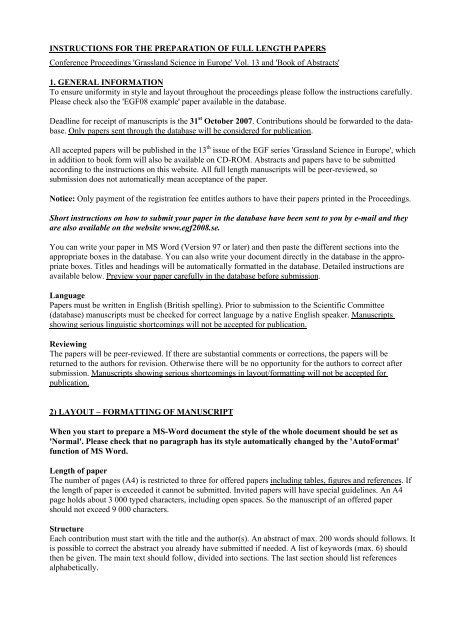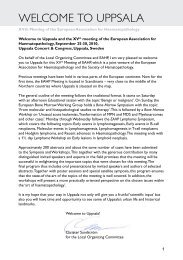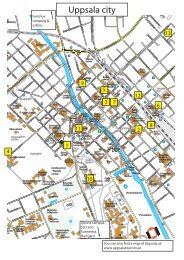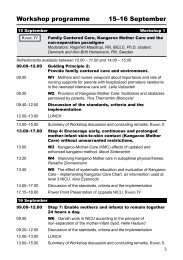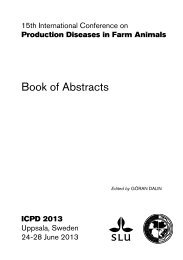Detailed instructions for full length paper
Detailed instructions for full length paper
Detailed instructions for full length paper
You also want an ePaper? Increase the reach of your titles
YUMPU automatically turns print PDFs into web optimized ePapers that Google loves.
INSTRUCTIONS FOR THE PREPARATION OF FULL LENGTH PAPERS<br />
Conference Proceedings 'Grassland Science in Europe' Vol. 13 and 'Book of Abstracts'<br />
1. GENERAL INFORMATION<br />
To ensure uni<strong>for</strong>mity in style and layout throughout the proceedings please follow the <strong>instructions</strong> care<strong>full</strong>y.<br />
Please check also the 'EGF08 example' <strong>paper</strong> available in the database.<br />
Deadline <strong>for</strong> receipt of manuscripts is the 31 st October 2007. Contributions should be <strong>for</strong>warded to the database.<br />
Only <strong>paper</strong>s sent through the database will be considered <strong>for</strong> publication.<br />
All accepted <strong>paper</strong>s will be published in the 13 th issue of the EGF series 'Grassland Science in Europe', which<br />
in addition to book <strong>for</strong>m will also be available on CD-ROM. Abstracts and <strong>paper</strong>s have to be submitted<br />
according to the <strong>instructions</strong> on this website. All <strong>full</strong> <strong>length</strong> manuscripts will be peer-reviewed, so<br />
submission does not automatically mean acceptance of the <strong>paper</strong>.<br />
Notice: Only payment of the registration fee entitles authors to have their <strong>paper</strong>s printed in the Proceedings.<br />
Short <strong>instructions</strong> on how to submit your <strong>paper</strong> in the database have been sent to you by e-mail and they<br />
are also available on the website www.egf2008.se.<br />
You can write your <strong>paper</strong> in MS Word (Version 97 or later) and then paste the different sections into the<br />
appropriate boxes in the database. You can also write your document directly in the database in the appropriate<br />
boxes. Titles and headings will be automatically <strong>for</strong>matted in the database. <strong>Detailed</strong> <strong>instructions</strong> are<br />
available below. Preview your <strong>paper</strong> care<strong>full</strong>y in the database be<strong>for</strong>e submission.<br />
Language<br />
Papers must be written in English (British spelling). Prior to submission to the Scientific Committee<br />
(database) manuscripts must be checked <strong>for</strong> correct language by a native English speaker. Manuscripts<br />
showing serious linguistic shortcomings will not be accepted <strong>for</strong> publication.<br />
Reviewing<br />
The <strong>paper</strong>s will be peer-reviewed. If there are substantial comments or corrections, the <strong>paper</strong>s will be<br />
returned to the authors <strong>for</strong> revision. Otherwise there will be no opportunity <strong>for</strong> the authors to correct after<br />
submission. Manuscripts showing serious shortcomings in layout/<strong>for</strong>matting will not be accepted <strong>for</strong><br />
publication.<br />
2) LAYOUT – FORMATTING OF MANUSCRIPT<br />
When you start to prepare a MS-Word document the style of the whole document should be set as<br />
'Normal'. Please check that no paragraph has its style automatically changed by the 'AutoFormat'<br />
function of MS Word.<br />
Length of <strong>paper</strong><br />
The number of pages (A4) is restricted to three <strong>for</strong> offered <strong>paper</strong>s including tables, figures and references. If<br />
the <strong>length</strong> of <strong>paper</strong> is exceeded it cannot be submitted. Invited <strong>paper</strong>s will have special guidelines. An A4<br />
page holds about 3 000 typed characters, including open spaces. So the manuscript of an offered <strong>paper</strong><br />
should not exceed 9 000 characters.<br />
Structure<br />
Each contribution must start with the title and the author(s). An abstract of max. 200 words should follows. It<br />
is possible to correct the abstract you already have submitted if needed. A list of keywords (max. 6) should<br />
then be given. The main text should follow, divided into sections. The last section should list references<br />
alphabetically.
Page size and font is set as follows:<br />
- Page size is A4, all four margins are to be set at 2.5 cm.<br />
- Single line spacing and left-aligned text (the editor will correct the text from left-alignment to <strong>full</strong><br />
page width adjustment.<br />
- Font Times New Roman, size 12, except <strong>for</strong> tables and <strong>for</strong> the reference list; size 10 points.<br />
- Do not use bold characters or indentation.<br />
- When using the common name <strong>for</strong> plant species, please give the respective Latin name in brackets at<br />
first mention.<br />
- Use italics <strong>for</strong> Latin biological names, journal titles, <strong>for</strong> Latin phrases such as 'et al.' and also <strong>for</strong> the<br />
statistical parameters P (P < 0.001) and R 2 (R 2 = 0.87).<br />
- Do not use a hard return ('Enter') at the end of a line. Press 'Shift Enter' at the end of a text paragraph<br />
or a caption.<br />
- Turn the hyphenation option off.<br />
- Use single ('……') instead of double quotation marks (“……”).<br />
- For symbols and international characters, use the 'Insert/Symbol/Times New Roman' option in Word<br />
or use the 'Insert Special Character' option in the database.<br />
Title and headings<br />
The title should have a maximum of 15 words. Latin names included in the title will be corrected into italics<br />
by the editor. Put the name of the author(s) and the address of the institute(s) directly in the database (this<br />
was already done when submitting the abstract). Please check the order of the authors care<strong>full</strong>y.<br />
The title and section headings should be typed in lower case letters and not in capitals. There will be only<br />
one level of headings permitted <strong>for</strong> the offered <strong>paper</strong>s. There will be some predestined headings (Abstract,<br />
Introduction, Materials and methods, Results, Discussion, Results and discussion, Conclusions, Acknowledgements<br />
and References). If needed, you can also choose your own heading.<br />
Footnotes should not be used. Put the in<strong>for</strong>mation in brackets at the appropriate place in the text.<br />
Tables<br />
Use the database table function to create your tables. It is not possible to merge cells. Lines in the table will<br />
be edited at a later stage.<br />
Figures<br />
- Bear in mind that the manuscript will be reduced when printed (to 80% of the A4 size) and that the<br />
size of lettering in a drawing/graph should never become smaller than 2 mm after reduction. When<br />
making a <strong>full</strong>-page graph it is advisable not to reduce the font size to less than 16 points. Please use<br />
font 'Arial' within figures.<br />
- Put the <strong>full</strong>-size (100%) originals at the correct place in the manuscript. Photocopies of artwork are<br />
unsuitable.<br />
- Bear in mind that a figure should take up not less than one third of the page <strong>length</strong>wise – this<br />
corresponds to 17 blank lines including the legend.<br />
- Give figure legends at the correct place in the manuscript in normal (regular) lower case letters.<br />
- Create a gif or jpeg file of your figure. Insert it in the database according to the technical <strong>instructions</strong><br />
sent out by mail/available on the website www.egf2008.se.<br />
- Please preview your <strong>paper</strong> care<strong>full</strong>y be<strong>for</strong>e submission.<br />
Photographs<br />
Photographs should be used sparingly. Bear in mind that the proceedings will be printed in black and white.<br />
Please use the 'Photograph button' in the database box to insert your photograph.<br />
Acknowledgements<br />
Any acknowledgements should follow the discussion. If references to grant support are cited, write out<br />
complete names of the funding agencies unless these are well understood, such as 'EU'.
References<br />
For references within the text: use the <strong>for</strong>mat 'author (year)' <strong>for</strong> a single reference only, or '(author, year;<br />
author, year)' <strong>for</strong> one or more references; please use round brackets only. Use 'and' and not '&'’. If there are<br />
more than two authors per reference, reduce to 'first author et al., year' (see the EGF08 example <strong>paper</strong>). If<br />
several <strong>paper</strong>s by the same first author or by first authors with the same surname and published in the same<br />
year are cited, the year of publication should be suffixed by the letters a, b, c, etc. All sources quoted in the<br />
text should be listed in the list of references at the end of the <strong>paper</strong>. Normally, no references should be given<br />
in the abstract. Example: Smith (1996) found that... or It has previously been shown that.... (Smith, 1996).<br />
For the list of references: Use 'Times New Roman' size 10, which is set in the database.<br />
References should be listed alphabetically. If there are more references by the same author, please place them<br />
in chronological order. Each reference should be arranged in the appropriate standard as follows (1. Journal<br />
title in <strong>full</strong>. 2. No commas after surname):<br />
For journal articles:<br />
Author(s) (year) Title. Journal Title (in <strong>full</strong>) volume number, page-page.<br />
Dulphy J.P., Demarquilly C., Baumont R., Jailler M., L‘Hotelier L. and Dragomir C. (1999) Study of modes<br />
<strong>for</strong> preparation of fresh and conserved <strong>for</strong>age samples <strong>for</strong> measurement of their dry matter and nitrogen<br />
degradations in the rumen. Annales de Zootechnie 48, 275-288.<br />
For book chapters or contributions:<br />
Author(s) (year) Chapter title. In: Editor(s) names (eds) Book Title (in <strong>full</strong>), Publisher, Address, page-page.<br />
Cherney D.J.R. (2000) Characterization of <strong>for</strong>ages by chemical analysis. In: Givens D.J., Owen E., Ax<strong>for</strong>d<br />
R.F.E. and Omed H.M. (eds) Forage Evaluation in Ruminant Nutrition, CAB International, Walling<strong>for</strong>d,<br />
UK, pp. 281-300.<br />
For whole books:<br />
Author(s) (year) Book title, Edition, Publisher, Address, pages.<br />
Frame J., Charlton G.F.L. and Laidlaw A.S. (1997) Temperate Forage Legumes, CAB International,<br />
Walling<strong>for</strong>d, UK, 336 pp.<br />
For conference proceedings:<br />
Author(s) (year) Title. In: Editor(s) names (eds) Proceedings Title. Proceedings name, Publisher, Address,<br />
page-page.<br />
Ritchie M.E. and Olff H. (1999) Herbivore diversity and plant dynamics: Compensatory and additive effects.<br />
In: Olff H., Brown V.K. and Drent R.H. (eds) Herbivores: Between Plants and Predators. The 38 th<br />
Symposium of the British Ecological Society, Blackwell Science, Ox<strong>for</strong>d, UK, pp. 175-204.<br />
For previous <strong>paper</strong> from Grassland Science in Europe:<br />
Use the same <strong>for</strong>mat as <strong>for</strong> a journal <strong>paper</strong> without including the conference title etc.<br />
Todorova P. and Kirilov A. (2002) Changes in permanent grassland composition and feeding value during<br />
the growing season. Grassland Science in Europe 7, 170-171.<br />
Use a hard return after each reference and no hyphenation. Do not leave blank lines between references.<br />
Abbreviations, units and numbers<br />
Only SI units and abbreviations should be used. Abbreviations should be explained when they first appear in<br />
the text. If a non-standard abbreviation is to be used extensively, it should be defined in <strong>full</strong>. For mineral<br />
contents in soil, fertilisers, manures, plants and animal products, etc., the elements (i.e. P, N, K, etc.) should<br />
be used instead of their oxides. Isotopes should be indicated as 14 C, 32 P, etc.; ions should be mentioned as H + ,<br />
Mg 2+ , etc. For molar concentrations italic M should be used. Write units of measurement in scientific<br />
notation (use kg ha -1 and not kg/ha, use Mg and not tonnes), concentration as g kg -1 or mg kg -1 and not as<br />
percentage (%) or as ppm.<br />
In numbers, use the '<strong>full</strong> stop' decimal separator instead of 'comma'. Use a 'comma' <strong>for</strong> thousands etc., e.g.<br />
1,230.4 (one thousand two hundred and thirty and four tenths) instead of 1230,4. Where a number does not
efer to a unit of measurement it should be spelled out unless it exceeds one hundred. Where a number begins<br />
a sentence it should also be spelled out. There should be a single space on each side of *, /, >,


